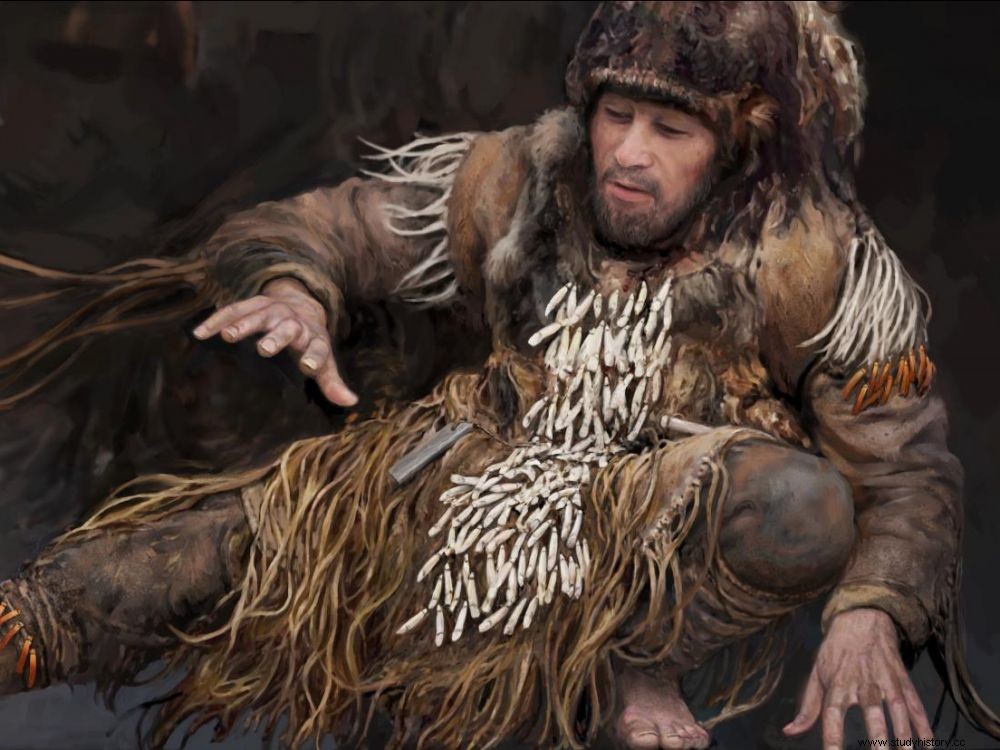The use of animal tooth pendants in rituals more than 8,000 years ago could have encouraged prehistoric hunters to dance, thanks to the sounds produced by the movements of the body.

Reconstruction of an adult man found in tomb 76a of the prehistoric cemetery of Yuzhniy Olenliy Ostrov, northwestern Russia, depicted dancing to the sound of 140 elk teeth.
Everyone knows the expression "chatter of teeth", but what about "chatter of teeth"...? Because it is quite possible to generate cowbell noises by making hundreds of rattles jingle, like so many rattles attached to clothes. This is described by a team of archaeologists from the University of Helsinki, Finland. "Wearing such bells will ring at the slightest movement ", says Riitta Rainio, the study's lead author.
The researcher danced for six hours straight to get those percussion sounds!
In an article published in the Cambridge Archaeological Journal , the researcher explains that she herself danced for six hours in a row for experimental research purposes to obtain these percussion sounds, while wearing sets of elk teeth (Alces alces ), one of the largest deer in existence. This specialist, accompanied by the Finnish artist Juha Valleapää, thus produced a performance whose aim was to verify the origin of the traces of wear:those found on the teeth of these animals when they collide with each other, and those left on the skin garments worn by men and women 8,000 years ago. "We were able to confirm that these marks do indeed appear when fresh elk incisor pendants - hanging in clusters - collide" , says Riitta Rainio, joined by Sciences et Avenir.
Reconstruction of dental ornaments found in tombs from the Mesolithic site of Yuzhniy Oleniy Ostrov, in northwestern Russia. 94 elk incisors sewn onto an apron made by Riitta Rainio collide and rebound on a skin support as the dancer moves:first at real speed, then in slow motion (–75%). The dress, work of Johanna Seppä is in reindeer skin. Video by Julia Shpinitskaya, Riitta Rainio and Kristiina Mannermaa.
"The noise of rattles obtained from moose teeth is fascinating"
This experiment was born following the discovery of hundreds of elk incisors in burials in the prehistoric cemetery of Yuzhniy Oleniy Ostrov, on the shores of Lake Onega, in the republic of Karelia, northwestern Russia. These were found in such quantities in the tombs - up to 300 teeth for a single deceased - that researchers have deduced that they must have been used as ornaments for the clothing worn by these Mesolithic inhabitants. This has been confirmed by numerous use-wear analyses, this method which makes it possible to study the traces of abrasion on archaeological objects, whether they are carved stones, ceramics or skins. "The noise of rattles obtained from the teeth of elk is fascinating because it transports the dancer into a thousand-year-old soundscape. The most impressive thing for me about this dance experience - which we dubbed "Stone Ageish Disco" - was the feeling that it was indeed the pendants I was wearing that were dictating the rhythm and movements of my body. It was not me who decided how to dance, but these ornaments whose movement I followed. It was liberating. After six hours of dancing, I couldn't stop! “, Riitta Rainio smiles. more than half contained these accessories. Mostly moose teeth, but also, more rarely, those of beavers, bears and wolves. Similar pendants have been found in other prehistoric cemeteries in far northern Europe, suggesting identical ritual practices.
